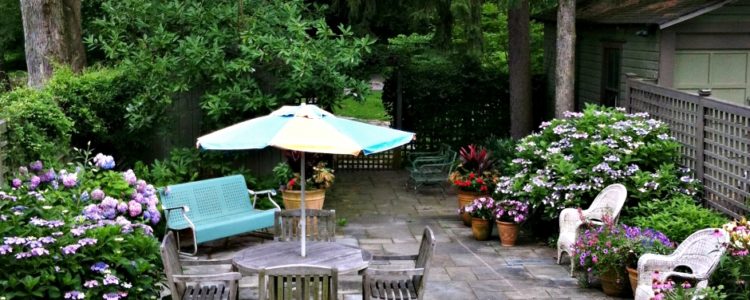In my garden, Hydrangeas are the gift that just keeps giving. From June until frost there is always a Hydrangea in bloom here. Once you start growing Hydrangeas you just can’t stop adding them to your garden. Just ask Michael Dirr, the famous plantsman, who has written an entire book on Hydrangeas, “Hydrangeas for American Gardens”. While researching for his book in England, Dr. Dirr visited a garden with approximately 360 cultivars of Hydrangea macrophylla. In his words, “The mind became mush, the knees buckled, and the camera imploded.” And that was just one species!
Hydrangea macrophylla or Bigleaf Hydrangea is the well-known species we grew up with. Its large pink to blue snowball flowers are seen far and wide. Because it doesn’t mind a bit of salt spray we find them growing abundantly from Cape Cod south along the coast to Cape May. If the weather is right they seem to flower forever, four weeks or more! Most flower on old wood, or on last year’s growth, so be careful not to prune too early or too late. The new Endless Summer Hydrangeas are an exception to this rule and will flower on the current season’s growth. They are good cultivars to grow if you have winter browsing deer in your Hydrangea garden or cannot coordinate a good time to prune.
Hydrangea macrophylla is not just a delicious bearer of snow cones, also referred to as hortensias. There are cultivars which produce another flower form called lacecaps. These have a lighter, more delicate appearance with a more flattened cluster of open blossoms on the perimeter of unopened buds. The colors are in the same range of whites to pinks to blues and mixtures depending on the acidity of the soil. My Tokyo Delight lacecap Hydrangea has been morphing from the palest blue to pink to rose for several seasons now. It began blooming the first week of July and is still holding onto its flowers in mid-August.
Hydrangea serrata is akin to Hydrangea macrophylla. Though said to be smaller in stature and flower than Bigleaf Hydrangea, my ‘Bluebird’ is the largest Hydrangea in my garden. It has certainly lived up to its reputation as a tough plant. The 90 foot oak tree that provided the perfect shade for my Hydrangea ‘Bluebird’ was felled two years ago, opening the site to hot afternoon sunlight. ‘Bluebird’ has stood the challenge! Its pale blue lacecap flowers are a bit paler. Still, it defies the hotter, dryer and brighter conditions. It has also withstood being topped by flood water four times as have all of my Hydrangeas.
Early to flower, Climbing Hydrangea (Hydrangea anomala subsp. petiolaris) is a true aristocratic vine. It is a climber able to cling to any structure displaying its beautiful leaves, white lacecap flowers and graceful habit. An ugly chain link fence can easily be disguised behind this lovely billowing vine. Small plants might take years to finally start growing and flowering. I tell customers to buy the largest plants they can afford to get off to a good start.
Oakleaf Hydrangeas (Hydrangea quercifolia) are large, white Hydrangeas perfect for a shady location. Put these at the edge of your woodland for the perfect light factor and to brighten up that spot from across the yard. They have huge elongated flower clusters, often 12 inches long that turn from white to pink, rose and red as the night temperatures dip.
At the back of my garden stands a Peegee Hydrangea (Hydrangea paniculata) I have trained to a tree form. Mostly available as white flowering types, mine is the little oddity, ‘Limelight’. The flowers open a margarita lime green in late July, turn all white by mid-August, then take on a dusty rose color as autumn temperatures drop, before drying to paper bag brown. Dried flowers can be cut and kept in a dry vase all winter indoors.
I don’t grow Hydrangea arborescens (Smooth Hydrangea) but I am adding it to my wish list. I have seen Hydrangea arborescens growing in very shady locations. It begins to flower in June with apple green flowers that turn off-white then brown with age. According to Dirr, Hydrangea arborescens flowers on NEW wood and makes excellent dried arrangements. Now where can I plant one?
